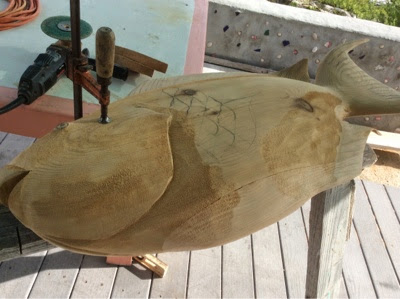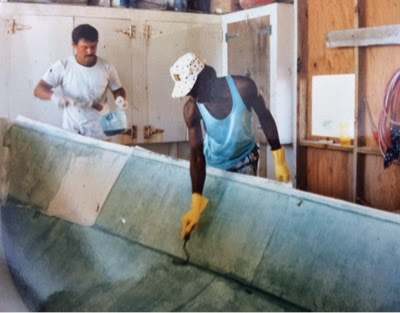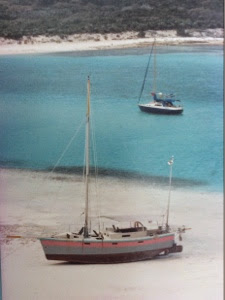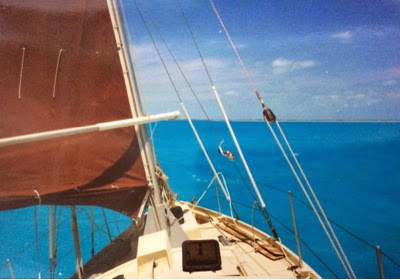This past month I have had the opportunity to go through all my old photos of sailing, raising our girls, and looking over some pictures of the beginning days of HBBWs . Rachel and I will be off sailing for a couple of years or more so were taking this time to reminisce.
Since posting some of these old pictures of my flats boat designing and building days I have gotten a very nice amount of responses with thank yous and lots of skiff questions. This has been fun for me .
On my facebook page I have had a bunch of freind requests from avid skiff owners and fisherman. Lots of these guys do not own one of my past skiffs but just want to talk skiffs. This I like doing very much.
From their profile pages I get to see lots of different skiff pictures.
A few years ago coming back from the West Indies to St. Augustine to build a trimaran I collected a bunch of stuff from my time at HBBWs when passing by our place here. I wanted to pass some things on to Scott Peterson who had bought HBBWs from the bank after it went bankrupt. Scott had reintroduced my name back into HBs history so I wanted to say thanks for this by giving him the original Whipray half model that I had made to take the lines off of to loft the skiff. I also gave him all the original sale brochures , a hat and the photos that I took of building the Whipray plugs and molds under a plastic tarp up in ST. Augustine. Scott and I talked for an hour and he graciously lent me my old mold for the ultimate dinghy. My original skiff had been stolen the year before in the Grenadines
So I got to build a new one. While waiting an hour for Scott to show up to meet me , as he had forgotten about our appointment I got to look around my old shop and talk to a couple of past employees. I have to say my time with Scott and seeing how the shop was being run was a big let down. Was not impressed.
Fast forward to this year my daughter emails me to look at the HB facebook site and watch the video of Flip , Chris and one of HBs employees listen to Flips version of how we came up with the Whipray design and what HB was all about at that time. This was Chris Petersons promo of re selling the idea of a legend. Flip tells his tale and fortunately includes Hal Chittums name in this. Of course Hal no longer exists in the current HB lore as I guess Chris Peterson is miffed at him for starting another company and dissing HBs old designs to promote Hals new boat ideas. Lots of things Hal has said about our original ideas and his new ideas are true. Did not bother me. I don't agree with Hals new boat construction and all the hoopla that goes with it but I like some of his skiffs details. One thing I find disconcerting for Hal is claiming to spending a quarter mill on R&D for this skiff when he spent less than $35,000.00 on my Whipray design and all the plugs and molds. Inflation I guess ?
By my count Flip tells about 10 little fibs and miss truths in his recounting of how it all came about.
Some glaring miss truths are ,
- I did not make the half model in front of him .
- The photos I gave to Chris Peterson , they did not come from Flip.
- I am a boat designer and builder but not a flats fishing person, so why would i need to hook up with these two to build three skiffs when I could do this on my own at any time. I have never owned a flats skiff.
- When we started HB none of us had a clue about Vacume bagging. Thanks for the allocades Flip, but i'am no genius .
- When I sold out to my three HB partners I was making over six figures in salary with company sales going through the roof with very little company dept. The company failed after I was bought out and left.
I could go on. But why? Does not make a difference to the skiffs being built. But if you are buying into a name brand it would be nice to know how it all really came about. You are spending your hard earned money to be part of this.
I contacted Chris Peterson about this via email and said that a lot of what was said was off ,I could live with it but that the part of us partners not being good businessmen was not to my liking.
Chris emailed back and said it was Flips version and he had nothing to do about it. But he would like to know my version and he would post it on his web sites.
This started a few emails back and forth with me sending him my story to read and the photos of the early boats in my career to explain that Chris was alining himself up with a dubious tale.
This I did before posting on my blog, to give him first shot of what really went down with all the paperwork and photos to go with it. I had written my history down 2 years before but had not had the time to post it here. I felt it would be great for the current owner of a company that was being promoted as the end all to flats fishing would want to be part of this. I offered him copies of all the original lines drawings and all the info I had of HB. The very essence of the beginning of the " legend". For free, no strings attached.He never emailed back after receiving all you see on this blog.
I have not heard from him since.
When Chris Peterson bought Hells Bay he bought all the building processes, the ideas , the experience of Flip, Hal, myself and the employees that made Hells Bay a major player in the flats word. This he did with a bit of money.
The interm owner, Chris and who ever makes decisions in designing there has changed the bottoms a bit, made different models, but what makes Hell Bay Boats work is how they are built. Lots of other boat company's now benefit from this building , design, and engeneering process. I'am proud of the part I played in this. I really like seeing all the clones and the use of these past ideas. Some are getting it and improving on HB.
Today Hells Bay Boatworks is a major name brand in the industry. This has been accomplished by very good advertizing , marketing, and the money it takes to make this happen. It's not cheap.
It's very nice to see all the clout of HB going to all these good causes.
I wish the best for the Petersons and HB but till this company comes out with a new ground breaking design by their pro staff they are just living and reinventing the past.
And so are all the other company's that are making facsimiles .
Flip Pallot , Hal Chittum in the first production Hells Bay Whipray at 12:00 at night at the boat ramp in Tittusvlle dying to go for our first ride. I just finished rigging the skiff. The photos are taken by me as Rachel was on the boat with our kids. We were still living on the original Hogfish.
Flip and Hal untying the skiff
Hull number one of the Whipray. The skiff you see with Flip in on HBs facebook site is the hull I built in St. Augstine.
The real Founding Fathers of Hells Bay Boatworks. Hals wife Jamie owned 26% but stayed out of the picture .
This is a picture of Flip on HBBWS facebook page today that states he is the founding father of Hells Bay.
This is the skiff I built under the tarp. It would be nice if Chris Peterson would tell the complete story of HB instead of rewriting it.
Boy that old skiff is sitting low in the stern , but Flip is a big guy. See the low Chines.
Whipray hull # 1 which was the prototype at Frank and Liz Steels Fly shop in the first few weeks of moving to Tittusville and starting up HB. This is the water tank that we had just done at the Huston Shallow Water Boat show.
Starting to build the predecessor of the Whipray on an island in Marathon Florida.
My daughter Lillian in this picture turns 20 next week. Give me a project and I will build it anywhere.
Myself , Tom Gorden , and an onlooker while we bag the first HB skiff. My Bilabong is starting to show!
Stan Nash and I making patterns for the first skiffs.
A bit of the past, now what shall the future hold?




































































